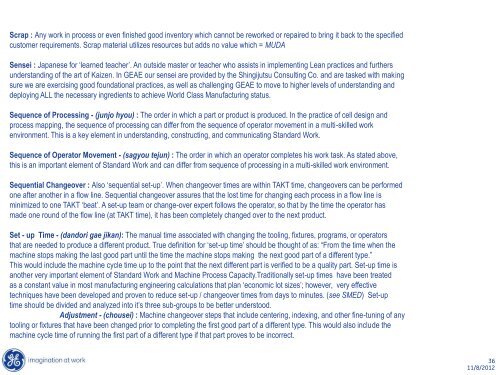Download Presentation - GE Capital
Download Presentation - GE Capital
Download Presentation - GE Capital
Create successful ePaper yourself
Turn your PDF publications into a flip-book with our unique Google optimized e-Paper software.
Scrap : Any work in process or even finished good inventory which cannot be reworked or repaired to bring it back to the specified<br />
customer requirements. Scrap material utilizes resources but adds no value which = MUDA<br />
Sensei : Japanese for ‘learned teacher’. An outside master or teacher who assists in implementing Lean practices and furthers<br />
understanding of the art of Kaizen. In <strong>GE</strong>AE our sensei are provided by the Shingijutsu Consulting Co. and are tasked with making<br />
sure we are exercising good foundational practices, as well as challenging <strong>GE</strong>AE to move to higher levels of understanding and<br />
deploying ALL the necessary ingredients to achieve World Class Manufacturing status.<br />
Sequence of Processing - (junjo hyou) : The order in which a part or product is produced. In the practice of cell design and<br />
process mapping, the sequence of processing can differ from the sequence of operator movement in a multi-skilled work<br />
environment. This is a key element in understanding, constructing, and communicating Standard Work.<br />
Sequence of Operator Movement - (sagyou tejun) : The order in which an operator completes his work task. As stated above,<br />
this is an important element of Standard Work and can differ from sequence of processing in a multi-skilled work environment.<br />
Sequential Changeover : Also ‘sequential set-up’. When changeover times are within TAKT time, changeovers can be performed<br />
one after another in a flow line. Sequential changeover assures that the lost time for changing each process in a flow line is<br />
minimized to one TAKT ‘beat’. A set-up team or change-over expert follows the operator, so that by the time the operator has<br />
made one round of the flow line (at TAKT time), it has been completely changed over to the next product.<br />
Set - up Time - (dandori gae jikan): The manual time associated with changing the tooling, fixtures, programs, or operators<br />
that are needed to produce a different product. True definition for ‘set-up time’ should be thought of as: “From the time when the<br />
machine stops making the last good part until the time the machine stops making the next good part of a different type.”<br />
This would include the machine cycle time up to the point that the next different part is verified to be a quality part. Set-up time is<br />
another very important element of Standard Work and Machine Process Capacity.Traditionally set-up times have been treated<br />
as a constant value in most manufacturing engineering calculations that plan ‘economic lot sizes’; however, very effective<br />
techniques have been developed and proven to reduce set-up / changeover times from days to minutes. (see SMED) Set-up<br />
time should be divided and analyzed into it’s three sub-groups to be better understood.<br />
Adjustment - (chousei) : Machine changeover steps that include centering, indexing, and other fine-tuning of any<br />
tooling or fixtures that have been changed prior to completing the first good part of a different type. This would also include the<br />
machine cycle time of running the first part of a different type if that part proves to be incorrect.<br />
36<br />
11/8/2012








